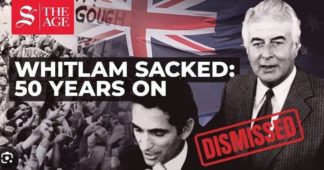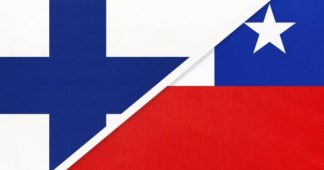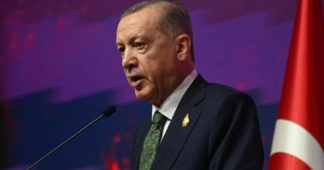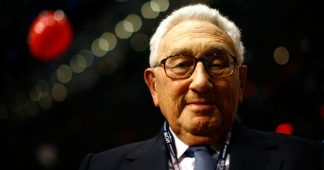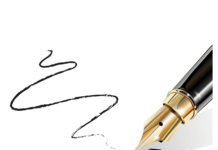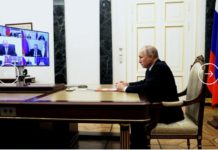The Dismissal coup was more like Chile 1973 than anything in our own prior history. Here’s one telling of it that brings it all together…
By Guy Rundle
Nov 11, 2025
(well folks – another big one. If this is the sort of stuff you think is missing in all but a few other outlets (which, ha, won’t publish me either), take out a paid subscription. Otherwise it’s more deserts, more profits….GR)
It was fifty years ago today…
Your correspondent does not propose to rehash every aspect of the Dismissal, the parliamentary and constitutional maneuvers, Junie Morosi, the Knight of the Long Prawns and all that.
Jenny Hocking has given an exhaustive account in her Whitlam biography, and Crikey subscribers can access my series of articles done on the occasion of the 40th anniversary. I have not yet read the Boy Bramston’s new Whitlam groaner (the sound one makes reading Bramston), but given what he is on the record as thinking the Dismissal is, I would advise not bothering. And I’ve got a long piece in Jacobin online, landing this week, so check that out.
The simplest and neatest thing to do here is to set out the argument as to why the Dismissal should be seen as a coup, in which the role of US power should be seen as uppermost to the constitutional, personal and royal finagling of Kerr, Fraser, Garfield Barwick, the Palace, and others.
To anyone who examines the fullness of the evidence, it can be seen as little else. The Dismissal – the fusty name, like the Malayan Emergency, hides its character – should be seen as part of a series of US interventions dating from the decisive interventions in Guatemala and Iran in the 1950s, and running through South Vietnam, Indonesia, numerous smaller sideshows, and all the way through to Chile in 1973. The Dismissal is more or less twinned with the Chilean coup, the bloodless version of that rather bloodier event. It is best understood in those terms. One of the reasons it hasn’t been, has been due to a long split on the radical left as to what sort of global entity Australia is, to which I’ll return.
The geopolitical version is this. In 1967, Gough Whitlam, a left-liberal social democrat, son of a senior public servant, a man who had never had a fellow travelling, Communist or even radical socialist past, took the leadership of the Labor Party, and, with a young team, began to modernise it politically, socially and organisationally. He was a supporter of the US alliance; he admired the Democratic Party, and its broad-tent politics. But he was taking over a Labor party with a substantial and genuine Left current (about to be formalised as a faction), in a country which still had a substantial Communist movement, as represented in union leaderships, and with several covert members among Labor MPs (oh yes, there was).
By the time Whitlam gained power, the US was struggling to maintain projected global power. It had lost in Vietnam, which suggested it had lost East Asia. Allende’s election in 1970 showed that a former ally could be taken through the ballot box. The CIA had lost any reticence about geopolitical ops – indeed its budgetary survival rather depended upon them. By the time he became prime minister in 1972, the ‘New Frontier’ had been closed, and he was facing the Nixon administration, most conspiratorial and anti-democratic government in its history, a gang who saw politics purely through the concept of ‘the enemy’. Some in the US government saw him accurately, as a social democrat with a Left to deal with. The core of the Nixon government saw him as some anti-American crypto-communist. They were concerned from the start, by a promise Whitlam had made that was barely noticed in the 1972 election, focused as it was on no-fee education, a public health system, and sewering the outer suburbs. Whitlam had made a commitment to seek closer ties to the Non-Aligned movement, the third tier of nations, its most prominent members being India, Yugoslavia and others. Moving Australia closer to the non-aligned camp would put pressure on the Australia-US alliance, and one aspect above all: the hosting of three radar spybase facilities, the most famous and powerful being Pine Gap near Alice Springs. Built by Americans in the 1960s, staffed by Americans, with US military law running writ, Pine Gap’s hemispherical position and powerful global surveillance capacity, gave the US a surveillance power that the USSR could not match – and did not know it was not matching.
This concern unquestionably predated any actual relations between Whitlam and Nixon. But any chance that things might run smooth was destroyed in December 1972, when the US conducted the Hanoi Christmas bombings, as a last feint in the Vietnam War, aimed not at victory, but at getting North Vietnam to accept a lesser peace deal than they could otherwise demand. Whitlam made private criticisms of the bombings to Nixon; Labor’s left, led by Jim Cairns, was not so reticent. As James Curran noted, Nixon was as outraged by Whitlam’s private protest, as by being called a genocider by the country’s deputy prime minister.
In 1973, things were made very much worse, when Whitlam issued a threat to outgoing US ambassador Walter Rice, about the US’s taking over Australian agricultural export markets, with its hugely subsidised agribusiness sector. ‘Don’t try to screw us or bounce us’ Whitlam said ‘or Pine Gap and the other bases come into play’. This was a blunder that Whitlam walked into, for the simple reason that he had no idea of Pine Gap’s supreme importance in the Cold War. Very few Australians did. One who did was Sir Arthur Tange, public service head of the Defence department. He was happy to keep a full briefing from Whitlam. So Whitlam was playing a far bigger chip than he could have known, believing the bases to be among the many bases the US had scattered round the world. This was virtually simultaneous with initiatives on the Non-Aligned movement. Australia had invited the President of Yugoslavia (not Tito, a minor figure) to visit. The Yugoslavs had refused until Australia had rounded up cells of Ustashe fascists who were present among immigrant Croatian Australians. The government felt ASIO was dragging its feet on the matter, to make the visit impossible. So on 16 March, in one of the most extraordinary events of the Cold War, the attorney-general Lionel Murphy led a raid on ASIO’s HQ in Melbourne, and carted away huge numbers of files (Murphy, it should be said, was most likely also looking for what ASIO had on Lionel Murphy, and other members of the Whitlam government).
The Americans had been apoplectic about the threat to the bases. The ASIO raid made them incandescent. It was the first time in which a government in the ‘Five Eyes’ (US-UK-Aus-Canada-NZ) spying alliance. In this, by common agreement, spy agencies were in a state of exception, subject to virtually no oversight, and communicating agency to agency. This was, counter-intelligence spy master James Jesus Angleton would later tell Australian journalist Phil Frazer, a raid on the ‘crown jewels’, exposing US shared secrets to foreign governments.
Now the story, already strange, gets stranger still. For in 1974, the Americans got two great pieces of good luck. The first was the appointment by Whitlam of Sir John Kerr, a move that bewildered those around him. Whitlam is said to have believed that Kerr was so broken down that he could control him if required, and also that they needed a Labor figure with some vice-regal affinities. And, from the heights of his triumph, Whitlam had some sympathy for someone who had once been thought of as a future great man, for whom it had all gone wrong.
This aspect of this extraordinary event is the least understood. Kerr’s buffoonery hides Kerr, the man, as he was seen for twenty years – as a great man striding across a small nation. Kerr, a working class boy, brilliant graduate of Fort Street selective high school, had quickly acquired a reputation in the 1940s as a fire-breathing radical lawyer, a Communist fellow traveller, a leader. Broad shouldered, rock jawed, an early proto-feminist – he was remembered by one friend as ‘stirring soup on the stove, with a baby on his hip, and reading Schopenhauer’ – everyone thought that Kerr was destined for greatness. He came close. He was part of the shadowy Army Directorate in the 1940s, and in that role spent time in Washington as liaison to the OSS, concerning the post-war future of British Borneo (he, and others, wanted it as an Australian protectorate, part of a Pacific empire). When Doc Evatt went as our representative to the UN, and was, for alphabetical reasons, its first secretary-general, Kerr was at his elbow as his consigliere. And then?
And then there is the most paradoxical part of the story, because there can be no doubt that in the 1940s, John Kerr damaged his chances of a conventional rise to power and fame, through an act of conscience. He had become steadily unenamoured with official Communism after the Second World War – and our side seeking to defend the militant record of the Communist Party (and yes, the film festivals and the fucking jazz) can glide over the the strategic cynicism and sleazy dimension of the movement. Kerr was, by this time, friends with Whitlam. The two families holidayed together. Richard Hall in The Unknown John Kerr records a conversation they had one summer, standing knee deep in the water at the beach. Whitlam argued that Labor was worth sticking with as a democratic socialist force. Kerr argued that it was dominated by Communists, and that he was breaking from it. In 1950, he was barrister in the Ironworkers Union case, in which a failed candidate for the leadership, Laurie Short, accused the successful Communist Party candidate of wholesale fraud. Again, the politics are complicated; Short had initially been part of a Trotskyist group in the Balmain dockyards, challenging the party from the Left. By the time of the Ironworkers challenge, which prompted Robert Menzies’ attempt to ban the Communist Party, Short was backed by Bob Santamaria’s movement.
Short’s challenge caused him to be taken up by the US, as the Cold war began in earnest. Short toured the US, an example of ‘fighting the Reds’ in the labour movement, and the US poured money into what would become – largely through that money – the solidified faction of the NSW Right, corrupt and clientelistic from the start.
So Whitlam and Kerr’s fates split. Whitlam, the dashing Fabian, saw the world in fairly conventional terms. Kerr, the Lenin and Nietzsche reader became another example of a certain type of cursed Australian – the one who wants the country, and life itself, to be more interesting than it is. Yet If Kerr’s initial motive was political and real, his follow-up was ambition itself. He jockeyed for the leadership of the local version of CIA front, the (Australian) Congress for Cultural Freedom, and was pipped. He started a local version of CIA front The Asia Foundation, but its success was middling. By the late 1950s, as Whitlam, member for Werriwa, was being talked of as a future leader and prime minister, a new type of Labor man, Kerr was falling into obscurity and alcoholism. He was saved, in the 1960s, by Sir John Carrick, NSW Liberal eminence grise, and Malcolm Fraser’s mentor, who persuaded Premier Bob Askin to take the audacious step – Kerr was still seen as a Labor man – of making him Chief Justice of NSW. This was, again, an act of personal pity, but it was also an astute spotting of someone pliable. It’s at this point that Kerr, having shed his revolutionary politics, ditched his working class rebelliousness altogether, taking on the trappings of the British establishment and accepting a knighthood. This was the man, a sort of reverse-engineered Frankenstein’s monster of the century’s passions, Whitlam thought he could control. That too was part of Whitlam’s fatal flaw. Having begun as an aesthete and a mild bohemian at Sydney Uni in the 1930s, politicised by war service and the rejection of the 1944 social services referendum, Whitlam never lost a performative irony about the vicissitudes of politics. Kerr, the working class kid who now looked like a buffoon, had been serious from the start. No-one forced Kerr on Whitlam, or positioned him, or anything. It was all Whitlam’s own work, rewarding the CIA for their cultivation of assets in the long game.
Their second piece of luck was the loans affair. This has been portrayed as a shambolic sideshow, which Whitlam was not aware of. In fact, the idea of seeking development loans had been a major part of the left’s programme, and though Whitlam was not as much at home with it as others, Jim Cairns had begun the process as Treasurer. It became more complex when Resources Minister Rex Connor took it over. Portrayed as a hayseed in memory, Connor was in fact a forward thinking man. He had been a fellow travelling Communist in his youth, then did well out of car dealerships, and moved from the left to the right within Labor. But he took a promethean politics with him. His idea for development was a joined up thing. Australia would borrow $4 or $8 billion in petrodollars from the Arabs, loaded after the oil price quadrupling, and looking for investment. Connor wanted to use the money to buy up foreign mining leases, then pump the money into a state owned nuclear industry producing virtually free energy, supercharging not merely Australian, but human development. Desperate to bypass the public service control over money markets, he tendered the process out in the East Asian financial press.
That’s the point at which the CIA had an entry, because, after twenty years of Vietnam, they had a battery of fake companies, banks, import-export agencies ready to respond. Denis Freney later did an overview of the dozen companies who responded, assessing half of them as some sort of front. Whether Tirath Khemlani was one of them at the time is uncertain. In 1981 he would be convicted of fraud in association with the Nugan Hand bank, an undoubted CIA front, so hmmmm it’s a mystery for the ages. Through 1975, Cairns misled parliament about the loans and had to go, Whitlam knocked Connor’s process on the head, and Connor kept going anyway. The Opposition had suspiciously good information on what was going on, including huge telephone transcript, probably provided by the peerless surveillance capacity of Pine Gap. Then Khemlani, pinged, came over to the Liberals (he was minded by the consumer affairs minister, one John Howard; the rodent has made no mention of this duty in his broadcast memories of the event). The government had its trigger to demand an election and refuse supply. John Kerr had his great historical moment to make something of.
From that point, mid-October 1975, things got seriously weird. Richard Hall, digging for anything to set up a flank attack, found Richard Stallings, an American ‘consultant’, Adelaide-based, whom Labor sources said had been getting drunk in parties and saying he was CIA and had set up Pine Gap, that he now has some remorse over being a spook, and that National Country Party leader Doug Anthony was financially bound up with him. It would quickly become apparent that Stallings was not on the list of CIA agents operating in Australia held by the government. But he was on a larger list, held by Sir Arthur Tange, permanent head of defence, and part of the ‘Commonwealth Club’ of senior public servants who saw themselves as a permanent government of prudence and continuity. Whitlam made more noises about the bases, and about the CIA in Australia, as parliament’s next sitting loomed closer – on November 11. Doug Anthony himself said he would raise the issue in parliament, to clear his name. Brian Toohey published Stallings’ name. Tange is said to have made intimations to Kerr that Pine Gap was something more than just another listening station. When that wasn’t clear – Tange barely understood the specifics himself – he sent John Farrands, the government chief scientist to brief Kerr. Farrands met Kerr in Melbourne on Monday 3 November 1975 – Kerr was there for the Cup – at the Watsonia radar base (itself part of the Pine Gap network). Farrands, a radio-physicist, could make it really clear how important this all was.
Kerr did not need the material as it were. Simultaneously with his now famous love letters to the Palace, chattering about protocol and reserve powers of the office, he had renewed his obsession with Communists in Labor (which, let’s face it, there were: the Gietzelt brothers, probably Bruce Childs and others). By this time, Whitlam, out of three years bitter experience, had moved left in geopolitical matters. In short order he had sacked the heads of both ASIO and ASIS; the former on the pretext of an illicit affair, but really to remove an old stager; the latter because the agency had flouted the ban on conspiratorial ops, running a whole political party in the newly-independent East Timor. Whitlam’s sacking of the ASIS head was said to be so loud and angry that it could be heard from the corridor. Kerr is said to have taken an especial interest in the sacking, and of Whitlam’s threat to dissolve ASIS altogether.
Then, the coup de grace. On Friday 7 November, Ted Shackly, CIA head of the East Asia desk, sent his ASIO opposite number a telex saying that if Richard Stallings was officially named in Parliament, and the bases put into play, all intelligence-sharing with Australia would cease. Kerr saw the telex. Whitlam too, but only because the new ASIO head leaked it to him.
On the morning of November 11, Whitlam went to Yarralumla, assuming he would get a half-Senate election from Kerr, as he was advising. He got the sack in an ambush, by a Cold War CIA man, a month before the leases of the US’s most important intelligence asset was to come under threat, and hours before a US ally parliament was about to put on the record exactly how the CIA worked. That, of course, never happened. Despite Fraser losing a vote of no confidence in the House after the Dismissal, Kerr refused to take the Speaker’s advice as to the matter, and prorogued Parliament, with Fraser in place as prime minister. The government had another nineteen days of funds on hand before supply ran out, and several Senate Liberal moderates were about to crack, and cross the floor, saving Whitlam and destroying Fraser. The Whitlam government might not have won the next election coming down the pipeline. It sure didn’t win this one. In any case, Fraser, as caretaker prime minister, had already extended the leases of Pine Gap and the other bases. This was quite beyond caretaker mode. But he had to, as the leases concluded on 9 December, a few days before the election.
Fraser consolidated control, though ran a more domestically moderate government than he, an Ayn Rand fan, might have done – spooked apparently, by the strength of the trade union campaign, and what it might do, if arbitration and other features were attacked. He also okayed the development of Australia’s end of the new ‘Echelon’ system, which broke down Pine Gap style surveillance into smaller, modular units, and is essentially the link between Pine Gap style approaches, and the total surveillance that Edward Snowden would reveal decades later. In 1978, Justice Hope delivered the 1974 commissioned investigation into Australian spy agencies. Hope was a friend of the agencies. Nevertheless, it proposed some limiting and greater oversight. Several weeks later, a bomb exploded outside the Hilton Hotel Commonwealth Heads of Govt Meeting, killing two garbagemen. And any talk of curtailing spy powers ceased. Nothing like the loans scheme was ever tried again. The resources of a nation that doesn’t have much else stayed in private hands. And, as many have noted, Norway, doing what we might have done, now have trillions in publicly managed funds. And we have the future fund, to pay public servants’ super. However hamfisted might have been the Whitlam government’s pursuit of it, its failure is a tragedy, and a foreclosure of history.
Labor descended into five years of civil war between left and right, with the NSW Right, now a US- and gangster-funded outfit escalating from branch stackings to bashings and probably murder. Always more numerous than the left, they prevailed. By the 1980s explicit promises were made on the US alliance, and fealty to global money markets and the US-dominated system. With that done, Murdoch’s News Corp felt safe to endorse Bob Hawke – himself a ‘friend of the Americans’ at the very least – as the next prime minister.
The official media ’cover up’ also began. Paul Kelly’s first edition of The Unmaking of Gough featured an entire chapter on the security dimension of the crisis. By later editions it had gone. Nothing better illustrates the hopeless broken-down fall of Kelly than that, the man who in 1975 led a strike at The Australian because its coverage was biased against Whitlam. What a pathetic end to come to, a Succession bit-part.
The 1980s miniseries left the whole issue out – possibly for narrative simplicity, but it was a significant omission. Coverage now has been predictably silent on this dimension in News Corp – the one veteran Troy Bramston hasn’t interviewed is John Menadue, Whitlam’s head of PM&C. Why? Because Menadue, once a centrist and sceptical figure, is now convinced that the US dimension was crucial, and in Pearls and Irritations is spelling it out, with details I’ve omitted here.
But Nine has avoided it, and so too has the ABC, Radio National Breakfast wittering on this morning, with ‘how did you feel at the time?’ drivel. Jenny Hocking (who does believe in the US influence) interviewed then, could have got a mention in, but stayed on the Palace beat (ah, yeah, you could have Jenny). Your correspondent pitched a book two years saying that the way to present the Dismissal for a new, and less anglo audience, was as part of the global Cold War, and to show how it was twinned with the Chile coup of 1973. Tanks and stadium executions for one place, legal maneouvres and pressure in another. It was knocked back, on the grounds that no-one would be interested in the Dismissal anymore. Or the publishers were not interested in that interpretation of the Dismissal.
Well, it is slipping into history now. But it carries history with it. In the person of Kerr, this extraordinary Iago, made of the century, bearing all its hopes, failures and squalor with him. Looking at the man and the events, I have no doubt that it was the cosmic struggle of the twentieth century that influenced him to believe that Whitlam and Labor was a security risk, to the whole chain of the West. Was he instructed, ‘push the button grey squirrel’? Of course not. This cartoonist idea of political action is what is used to deny the mountain of evidence as to how the developments of decades overdetermined the event. But I mean – there’s naming of CIA agents, threatening telexes, secret spy bases. It’s the Hollywood effect again. If you saw it in a cheap thriller, you’d say of course that’s how it happened, don’t be a fool. The demand for ‘smoking guns’, some sort of hand written confession by Kerr, or communique to him, is the way they persuade you not to trust your ‘lyin eyes’
That was Kerr’s moment in history, but he wasn’t taking it like a selfie, to be in the picture. He believed this was his role and his moment, the outcome of that division between himself and Whitlam all those decades earlier. Here is the ultimate paradox. To take the Dismissal seriously, you have to take Kerr seriously, scrape away the buffoon makeup and find the man, who like millions of men and women, made their commitment to one side or another of a struggle for what humanity would be. What is by any assessment a sideshow to the century, is also one of the most extraordinary stories within it, I have no doubt that, as the country changes, and those whose forebears have known the sharper end of American influence become more numerous, it will become the dominant understanding of what transpired. Between this oasis and the next mirage, comes the call in the desert: coup, coup, coup.
Till Friday…..
We remind our readers that publication of articles on our site does not mean that we agree with what is written. Our policy is to publish anything which we consider of interest, so as to assist our readers in forming their opinions. Sometimes we even publish articles with which we totally disagree, since we believe it is important for our readers to be informed on as wide a spectrum of views as possible.
